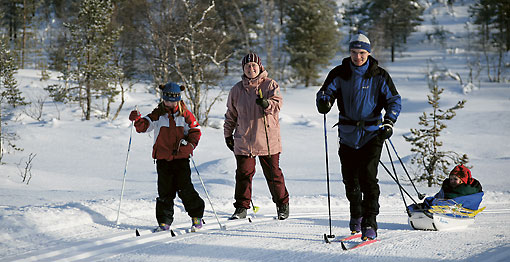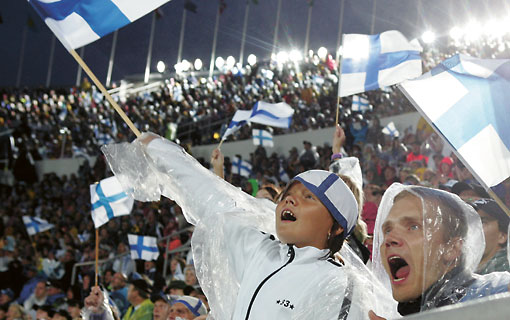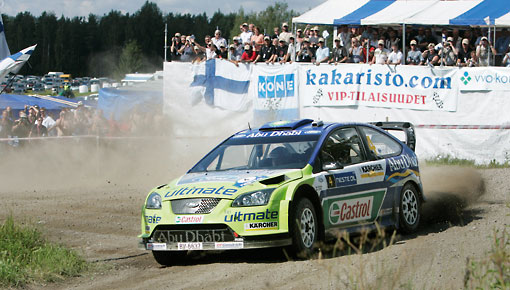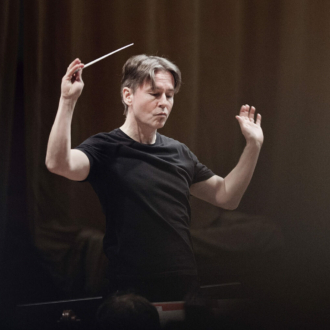It’s hard to imagine Finland without sports and exercise – keeping fit and active is second nature to the Finns.
According to a survey by the European Commission (2010), Finland tops the podium in physical activity in Europe, and it also places among the most active countries in the world. But we won’t rest on our laurels. We’re out to become the most active nation of all!
There are many reasons to exercise. You may have a competitive spirit or want to test your limits. You may be aiming to keep fit and look good, or you might simply want to relax and have fun with a group of like-minded people. Most Finns are active because it promotes health and wellbeing.
Sports – children’s hobby of choice
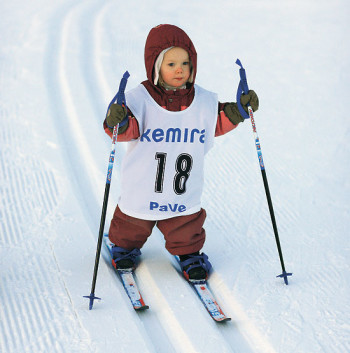
Children learn to ski at an early age.Photo: Antero Aaltonen
Sports are the number one hobby among children: More than 90 percent of those under 18 are physically active. Sports activities take place in clubs or in informal groups of friends. Favourites include football (soccer), ice hockey, floorball and various forms of gymnastics.
Of the adult population, 90 percent exercise at least twice a week and more than 50 percent at least four times a week. Adults favour sports that are easy to fit into their busy schedules, such as running, going to the gym and exercise classes that are conveniently scheduled at various times of day.
Active in sports clubs
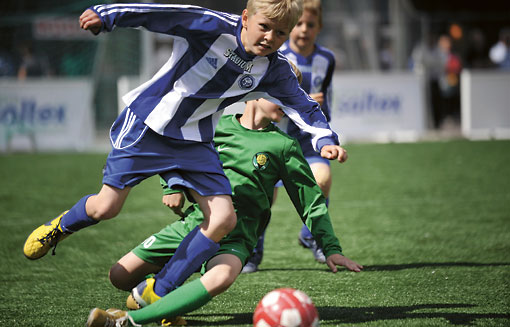
Soccer is the number one sport among children.Photo: Roni Rekomaa/Lehtikuva
their members in one or more sports. Clubs are run mainly by volunteers; most are non-profit organisations, with participation based on club membership.
Most sports clubs are members of a national association or a regional organisation. All national sports associations are members of the Finnish Sports Federation (FSF), including the 74 different sports federations, the Young Finland Association, the Finnish Olympic Committee and sports organisations for people who are disabled. FSF has a total of 130 member organisations.
The Finnish National Lottery is the largest individual financer of physical activities and sports. Some 25 percent of its profits are directed to sports through direct grants to clubs or via the Ministry of Education and Culture, which supports national sports organisations and municipalities. Municipalities maintain local sports facilities and provide financial support for local clubs. Other funding for sports clubs comes directly from the athletes or members, from sponsors and, to some extent, from the private sector.
In addition to clubs, independent fitness activity, company facilities and gym chains are becoming increasingly popular.
Volunteers keep the ball rolling
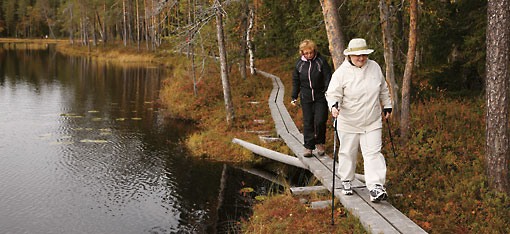
Numerous Finns keep fit by Nordic walking. The sport is also growing in popularity in other countries. Finland’s versatile natural environment provides good opportunities for open-air activities.Photo: Antero Aaltonen
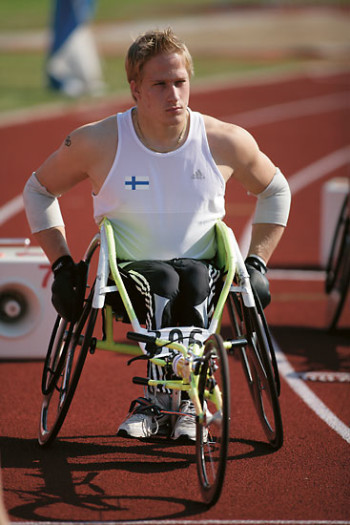
Leo-Pekka Tähti has won many Paralympic and World Championship medals in wheelchair racing.Photo: A Aaltonen
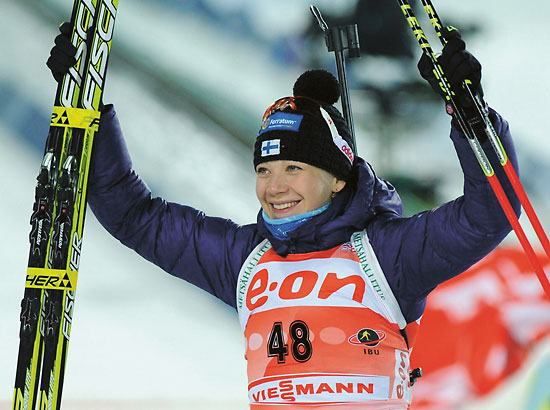
Kaisa Mäkäräinen is the first Finnish woman to win a gold medal in Biathlon. She won the 10-kilometre event and took silver in the sprint of the 2011 World Championships. In addition, she won the 2011 Biathlon World Cup.Photo: N. Kolesnikva/LK/AFP
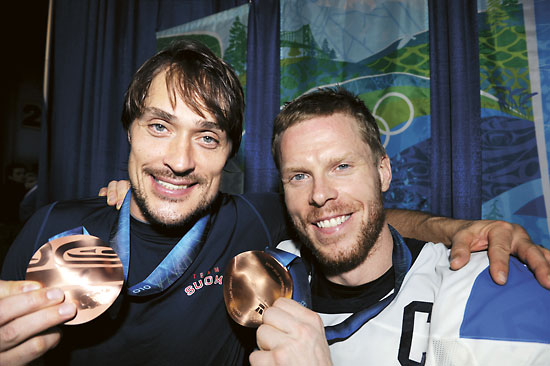
Ice hockey players Teemu Selänne (left) and Saku Koivu show offf their bronze medals at the 2010 Winter Olympic Games in Vancouver.Photo: Matti Kainulainen/Lehtikuva
Other famous Finnish sports stars include Lasse Virén (long-distance running) and Tiina Lillak (javelin); Juha Mieto and Marja-Liisa Kirvesniemi (cross-country skiing); and Matti Nykänen and Janne Ahonen (ski jumping).
Finns also tend to do well in motor sports, football and ice hockey. Juha Kankkunen and Tommi Mäkinen took several World Rally Championships, while Mika Häkkinen and Kimi Räikkönen have been Formula One champions. Teemu Selänne and Saku Koivu laced up their skates for Finland in ice hockey; Laura Lepistö and Kiira Korpi excel in figure skating. Famous Finnish footballers include Jari Litmanen, Sami Hyypiä, Mikael Forssell and Laura Österberg Kalmari, while Jani Sievinen and Hanna-Maria Seppälä are celebrated swimmers. In the Paralympics, successful Finns include Leo-Pekka Tähti (wheelchair racing), Jani Kallunki (judo) and Katja Saarinen (alpine skiing).
These and other talented athletes put Finland on the scoreboard and act as important role models for young sports enthusiasts.
Links:
Research Institute for Olympic Sports KIHU
Foundation for Sport and Health Sciences (LIKES)
UKK Institute
Did you know?
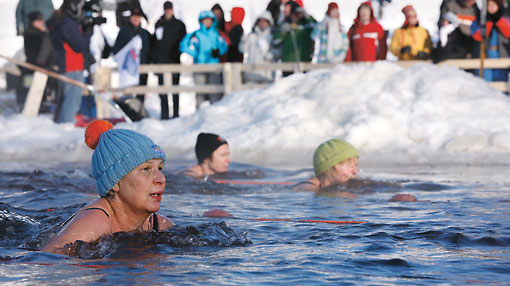
Winter swimming, also called ice swimming, is especially popular among women. A warmly dressed crowd always shows up to cheer the contestants in the annual Finnish Winter Swimming Championships.Photo: Antero Aaltonen
- Invented in Finland, Nordic walking (walking with poles that resemble ski poles) is in full swing: some 445,000 Finns keep fit by Nordic walking regularly. The sport is also growing in popularity in other countries.
- The sea and lakes freeze over in winter, but even so, some 120,000 Finns regularly swim in an avanto, a hole cut in the ice.
- Helsinki hosted the Summer Olympics in 1952.
- The national game pesäpallo, Finnish baseball, resembles American baseball. Developed by Lauri Pihkala in the early 1900s, it became popular in the military because it helped develop the many skills needed in national defence.
- Aesthetic group gymnastics originates in Finland, which is among the forerunners in this choreographic sport and Finnish teams have won several world championships.
- Finnish mountaineer Veikka Gustafsson is one of nine people who have conquered, without using bottled oxygen, all 14 of the world’s mountains that measure more than 8,000 metres.
- Ski jumping is one of the Finns’ all-time favourite spectator sports. Hours are spent in front of the TV watching the slow-paced competitions, which feature intermittent adrenaline rushes as each contestant speeds down a mountainside ramp and becomes airborne, attempting to soar over as much ground as possible before touching down.
- Some 354,000 Finns play floorball. In terms of membership, the Finnish Floorball Federation is the third-largest sports organisation in the country.
- The world’s largest gymnastics exhibition, Gymnaestrada, will be held in Finland; Helsinki will be full of gymnasts showcasing their skills in the summer of 2015.
- The expertise of Finns in the area of equality in sports was recognised when the chairpersonship of the International Working Group on Women and Sport (IWG) was handed to Finland for a mandate lasting from 2010 to 2014. IWG aims to promote equality for girls and women in physical education and sports worldwide.
- With the support of Finland’s LiiKe sports and development organisation, 11 teachers’ colleges in Tanzania have been granted the right to teach physical education and train PE teachers, supporting Tanzania’s aim to increase the PE curriculum in schools.
- Numerous national physical activity projects that aim for tangible results have been organised in Finland, such as the Fit for Life Programme, which encourages adults over the age of 40 to include physical activity in their daily routines. School children are inspired to get moving by the Muuvit adventure (further information on Fit for Life is available at www.kki.likes.fi, and Muuvit’s website is www.muuvit.com).
- Finnish company Suunto is the largest manufacturer of compasses and precision sports instruments worldwide, and a global leader in dive computers.
- Another Finnish company, Polar, was the first to launch a wireless, wearable heart rate monitor for athletes, in 1982. Polar’s heart rate monitors are used by everyone from top international athletes to hobbyists and beginners. Polar is a leading heart rate monitor manufacturer.
- An expert in play, Lappset Group is a top manufacturer of inspiring environments for play and games. The company designs and manufactures spaces and entire playgrounds for both children and adults all over the world.
By Katriina Sahala and Soile Koskela, Finnish Sports Federation (FSF), July 2011
